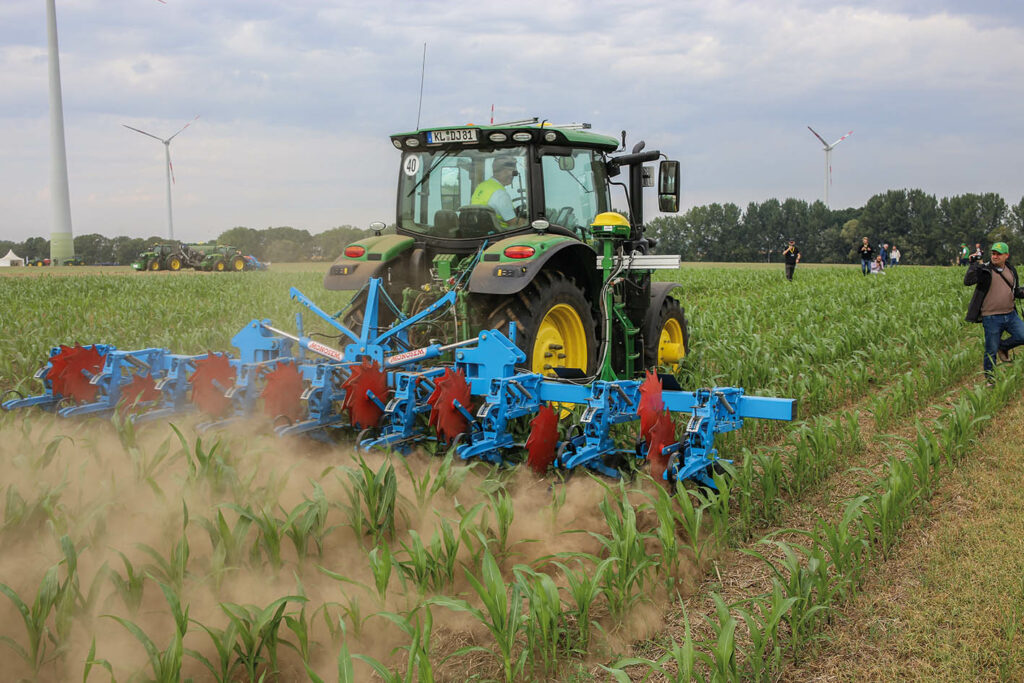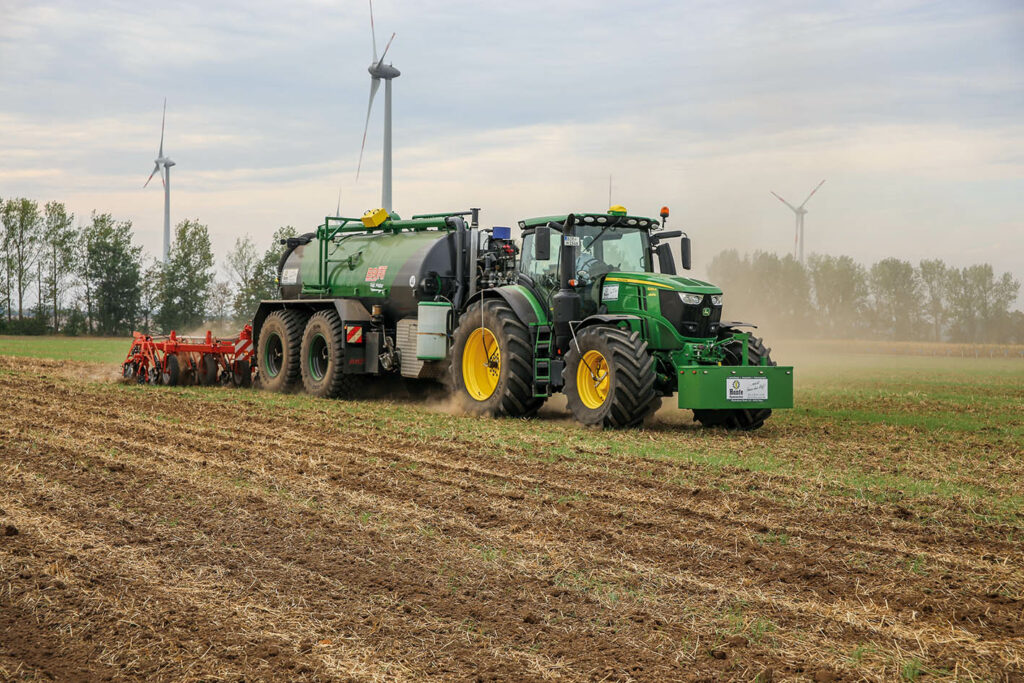Latest innovations in sustainable farming highlighted in Germany
21st October 2022
Farmers Guide attended an event in Germany at which John Deere explained and demonstrated new models and machine upgrades designed to contribute to sustainable farming. David Williams was there.
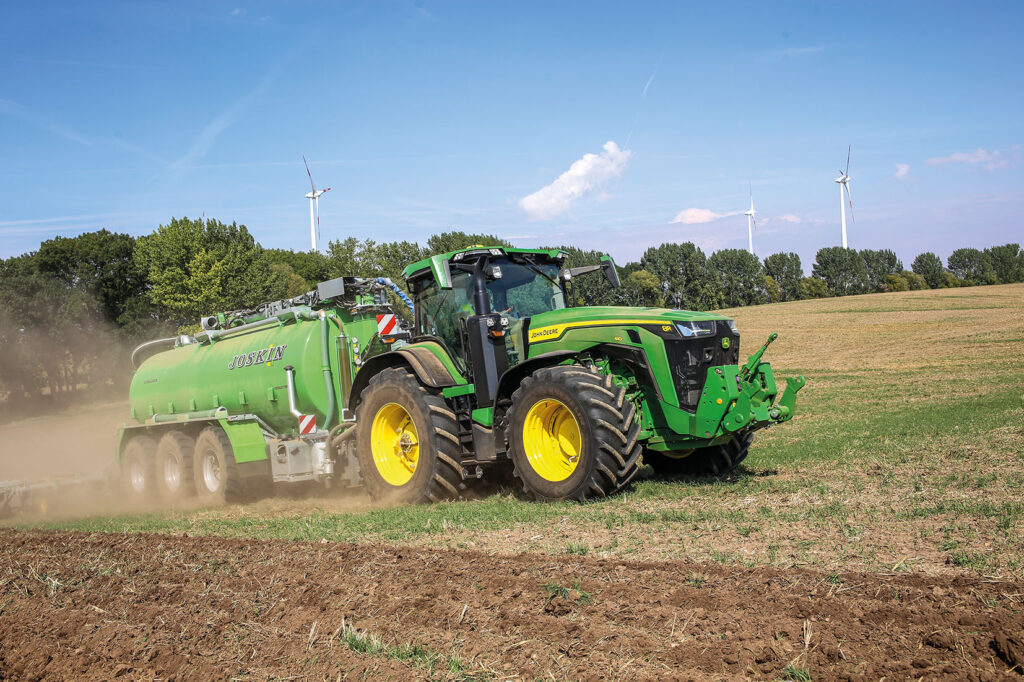
The event, near Berlin, included new technology as well as a reminder of what is already available. Highlights included an opportunity to see the new John Deere 8R410 with eAutoPowr CVT transmission in action, HarvestLab as a new option for John Deere combines, alternative fuels for tractors, reduced tillage crop establishment and reduced use of fertiliser and crop protection products resulting from more accurate applications.
Accurate measuring and monitoring
The event commenced with presentations from John Deere representatives and industry experts reminding attendees of the need for more sustainable farming to tackle issues including food security, supply and costs of resources and climate change. Methods of accurately measuring and monitoring during crop production are essential it was stressed, bearing in mind statistics including that 1kg of artificial fertiliser contains equivalent energy to 1 litre of diesel or heating oil, and techniques such as targeted spraying can reduce the amount of crop chemicals needed by up to 90%. Replacing herbicides with mechanical cultivations for some large-scale farming operations is becoming a practical alternative as precise guidance and steering allow hoeing at speeds up to 16kph, but a disadvantage is the increased power requirement and associated fuel use which contributes to CO2 emissions, and extra field traffic as more passes are needed which can result in soil compaction.
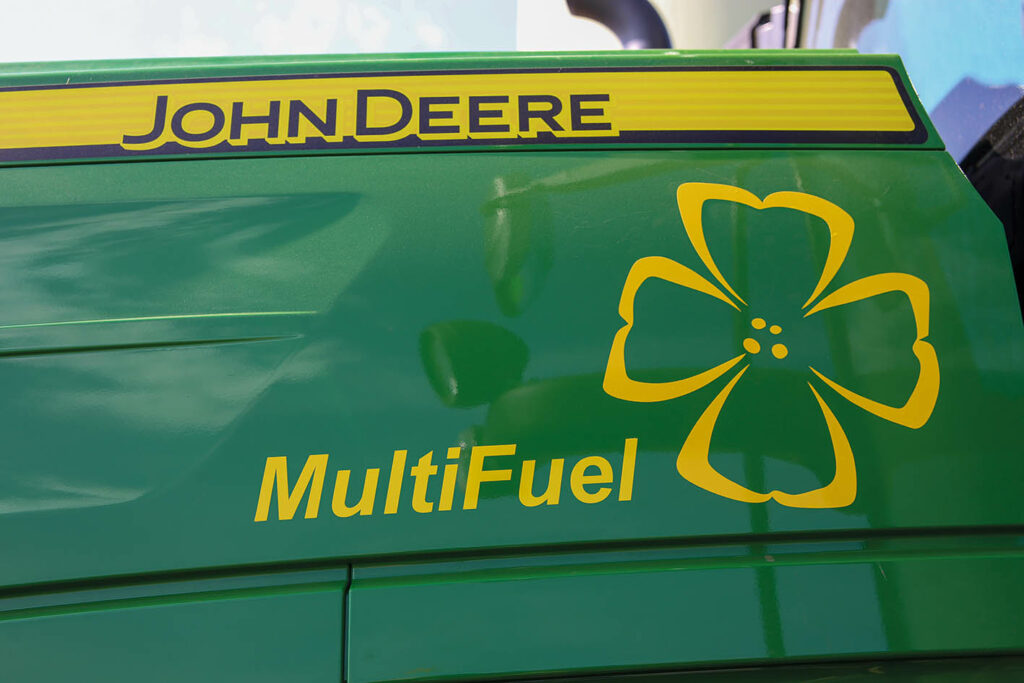
John Deere has produced a MultiFuel tractor capable of operating on diesel or biodiesel, or any mix of the two.
Alternative fuels
Challenges associated with moving away from diesel-fuelled tractors include that many farm tasks require machines to operate at or close to full load for full days at a time, which means battery power isn’t currently a viable option. However, as battery technology improves, John Deere believes that it could be an option as soon as 2026, but only for tractors up to 100hp due to the battery capacity required. However, by 2035–2040 there will be opportunities for larger tractors to use electric power, but in the meantime internal combustion engines will prevail.
It was pointed out that electric motors have four times the energy density of a diesel engine by size and weight comparison, so are a very compact solution.
Diesel-like fuels remain the best option – and multi-fuel solutions made from vegetable oils and biodiesel can be immediately available. Advantages include significantly reduced emissions and less pollution risk in the event of leaks.
Pure plant oils offer the highest energy density and have a high CO2 avoidance value, above or equivalent to 91%. It is easy to adapt current engine designs, and existing infrastructure can be used for storage and transportation. Growing crops for fuel, and then using the fuel in tractors creates an attractive agriculture to agriculture solution with a very affordable price, and oil from oilseed rape is also available as a by-product of manufacturing oilseed press cake which is a climate-friendly alternative to soya in cattle feed. Producing oilseed rape to manufacture cattle feed requires 20% less area than for the equivalent amount of soya.
Challenges with using vegetable oils include exhaust gas emissions, engine oil dilution and issues with cold starting in cooler climates. Few hardware changes are required, and in many cases only engine management software changes are needed. However, the main problem relates to legislation, as there is nothing currently available to permit tractors to operate on the alternative, more climate-friendly fuel.
At the event, John Deere displayed a 6R-series tractor capable of operating on diesel, biodiesels or any mix of the two, without adjustment and with the same power and torque characteristics as the standard diesel-only model.
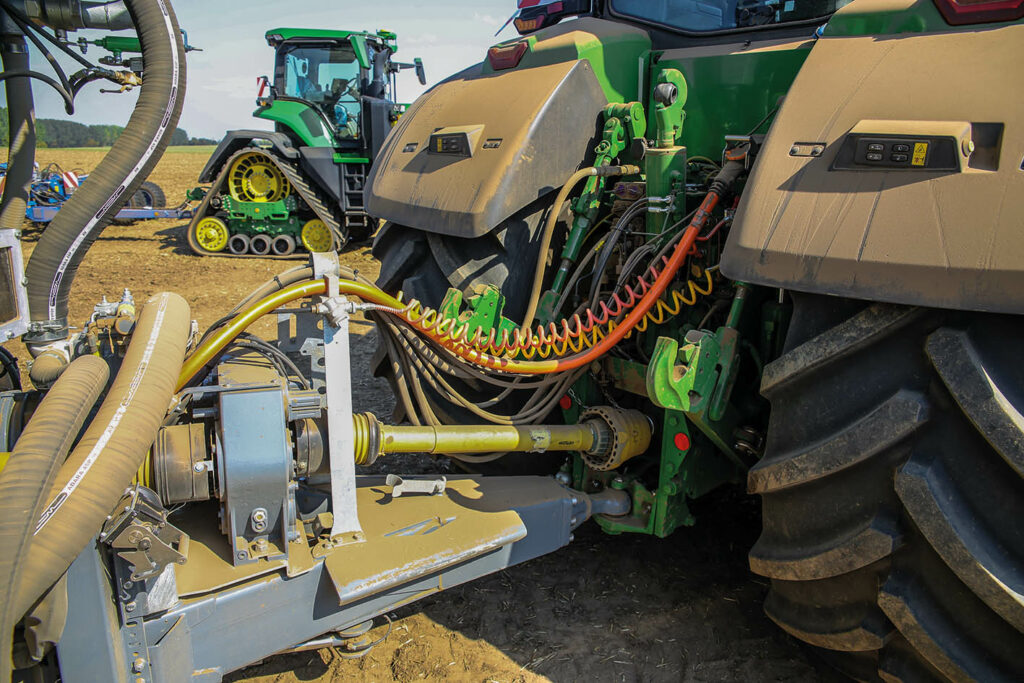
Electric drive
The orange electrical lead carries up to 100kW of 480V AC current to drive the tanker wheels. The PTO drives the slurry pump.
At Cereals 2022, John Deere exhibited its 8R410 eAutoPowr, which has an electric drive transmission. eAutoPowr is like the proven AutoPowr CVT transmission, but instead of a hydraulic drive section providing the variable speed, the new gearbox has an electric motor drive. More than 100,000 field test hours have been completed during development, and the new transmission is for use in tractors up to 450hp, whereas standard AutoPowr is available on models up to only 370hp.
The eAutoPowr transmission features a lifetime brushless motor which is almost completely wear free. The design is durable and simple, and operating diagnostics are available in real time.
There is also an opportunity to ‘off-board’ electrical power to run implements or other equipment using a power socket at the rear of the tractor.
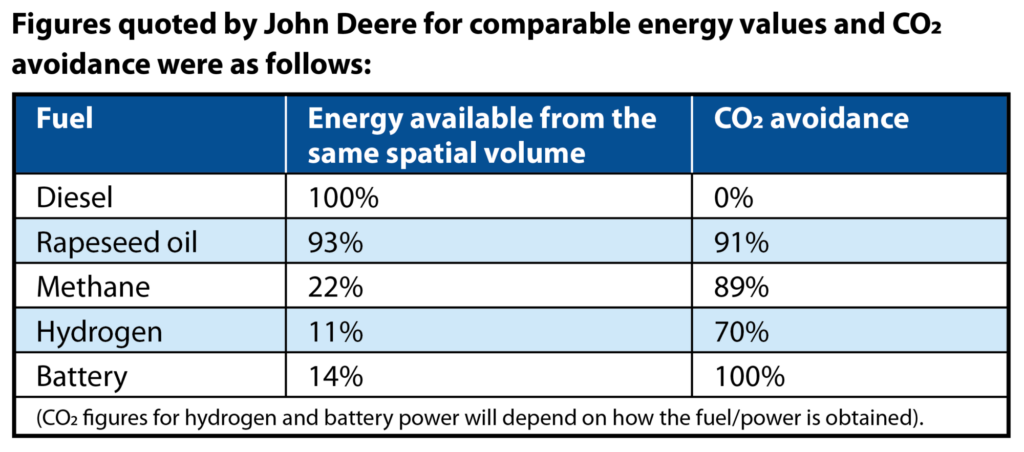
Convincing demonstration
The tractor was hitched to a 28m3 Joskin tanker full of water and with a rear-mounted injector, and four of the tanker’s six wheels were driven by a single electric motor powered by the tractor.
John Deere product manager for 7R, 8R and 9R series tractors, Jeremy Broatch explained that benefits of powering the implement’s wheels include:
- Improved traction
- Less wheel slip
- Precise tracking
- The ability to use wider implements, which means fewer passes are required
- The ability to support the tractor when needed.
Optimal weight distribution
Wheels directly below the tanker mean that the weight of the tanker helps provide traction allowing the power to be better utilised. In the case of the demonstration tractor and tanker, this meant that the tractor ballast could be reduced by 4t. The tractor and trailer combination was demonstrated travelling several times up a steep slope while injecting liquid – with and without the tanker wheels powered. The difference in tractor wheel slip, and the resulting wheeling depth were considerable.
The system is set up from the CommandArm terminal. The operator can specify a level of tractor wheel slip at which the powered tanker wheels assist. The driven tanker wheels can only assist movement, but never push the combination to avoid any risk of jack-knifing.
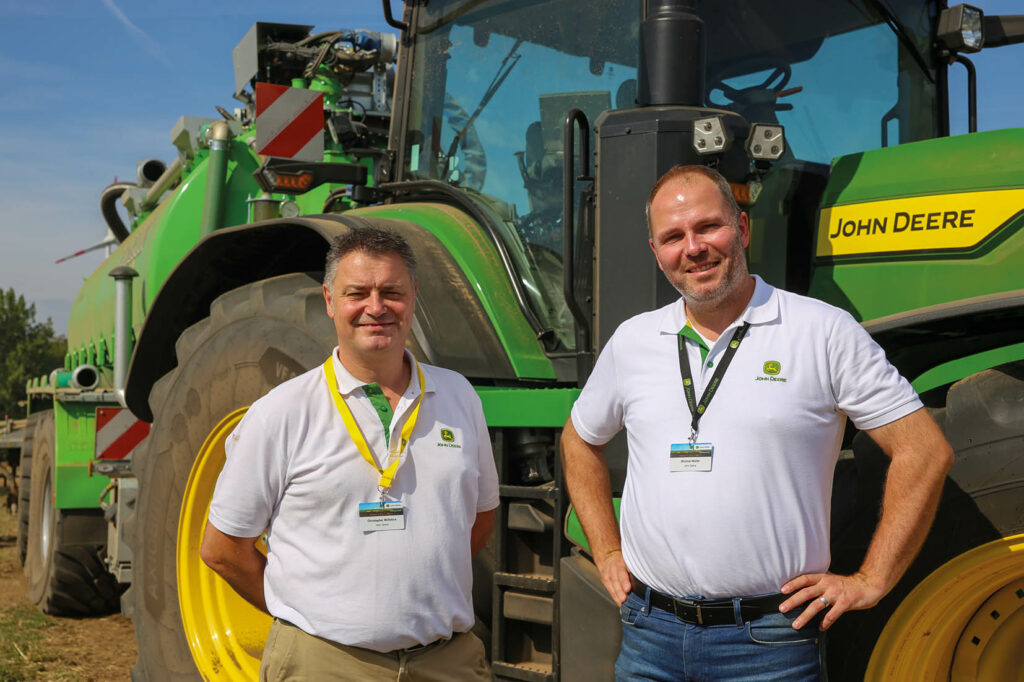
John Deere UK marketing manager Chris Wiltshire (left) with Jeremy Broatch.
Wider is more efficient
Jeremy explained that having more traction available means wider implements can be used, but the amount of total engine power dictates the speed. However, he explained that pulling a wider implement at slower speeds creates less resistance, so the same amount of power can be used to pull a 6m cultivator at 11.5kph, a 9m cultivator at 9.5kph, or a 12m cultivator at 8.5kph – if the traction is adequate. “Operating wider implements at lower speeds saves fuel,” he explained.
Jeremy also stressed benefits of powering the tanker wheels on side slopes, where there is reduced tendency to sideslip which means that slurry is injected precisely where needed.
Optimal power distribution
The 8R410 with eAutoPowr and the off-boarding option can supply up to 100kW to implements. “It still has only the same total amount of power available from the engine, but this system allows the power to be distributed between the tractor and implement for optimum efficiency,” he continued.
Between 0–4kph, all the power transmission is through the electric side of the gearbox, and the system will withstand direction changes under power at full load. “It’s durable and reliable,” said Jeremy. “Although conventional infinitely variable transmissions are also very reliable, if a failure occurs then it is most likely to be in the hydrostat. Replacing that section with an electric drive should improve reliability even further, and power transmission efficiency is slightly better too. However, our fully mechanical E23 powershift transmission will always have the lowest power loss.”
As well as offering eAutoPowr on the 8R wheeled tractors, the system will be an option for 8RX tracked models.
Smarter harvesting
HarvestLab was introduced as an option for the John Deere range of forage harvesters nearly 10 years ago, using near infra-red spectroscopy to analyse forage sugar and dry matter constituents based on images taken and immediately analysed as the crop passes a scanner on the chute. A few years later, the system won awards for its ability to analyse slurry content during applications. The liquid is analysed by the same HarvestLab sensor as it travels through the tube on its way to the distributor, helping prevent under or over application of particular constituents within the liquid and also contributing to accurate record keeping.
Now HarvestLab is an option for combines too.
The scanner unit is identical to the one used for forage and slurry and mounting it to a combine requires only an adaptor beside the clean grain elevator. Grain is scanned and analysed on its way to the tank.
Valuable data
Farmers and growers already have masses of data to manage and analyse, but the benefits of adding crop constituent mapping to the combine are considerable.
To illustrate the benefits, John Deere first displayed a standard field yield map highlighting variable yields across a field. Considering how to get the best possible results and obtain a consistent crop is always a challenge, and options include adding more fertiliser or increasing seed rates where yields are poor, or investing in soil analysis, or simply reducing inputs in the poor performing area and focussing investment in crop care and fertilisers in the areas where crops are yielding better.
However, when the crop constituent map was laid over the yield map, it was immediately obvious that crops in the poor performing areas had been affected by nutrient deficiencies. Therefore, it would be clearly worthwhile investing in extra fertiliser for these areas through variable rate applications.
If the HarvestLab data had shown crops in these areas to be high in nutrients instead, then an alternative course of action might have been to check for compaction or poor drainage, or soil quality.
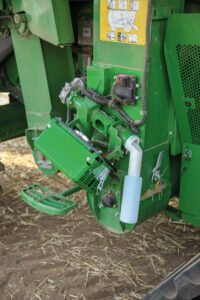
The HarvestLab sensor is mounted beside the clean grain elevator. This unit has a blue calibration tube attached.
Harvest logistics
HarvestLab on the combine provides real-time information regarding a wide range of crop data, including nitrogen content. For growers targeting premium markets, knowing the protein or nitrogen content at the time of harvesting could be very useful, especially where the crop quality is marginal. Using the data to help plan logistics is an option, and where fields include areas where crops are above and below a required threshold, then those harvested from areas where the target value has been achieved can be directed to one store, while grain failing to meet the required standard can be delivered elsewhere. As the farmer hosting the demonstration explained – once the crop is mixed in the store, it is too late to segregate it.
There are many benefits available from being able to map the harvested grain quality, suggested Dr Stefan Kubler at the event: “Using the same amount of fertiliser but targeting the application where it will achieve best results can be worth up to 50 euros per hectare.”
John Deere UK marketing manager Chris Wiltshire said that there has already been considerable interest in fitting HarvestLab to combines. “With the addition of a fitting kit, the system can be retro-fitted to existing combines, and current in-cab terminals can receive the required software upgrade through an activation code. The new option is very well timed to provide farmers with maximum benefit as crop and fertiliser prices are so high, and we expect it to be popular – especially where farmers or contractors can share it between a forage harvester or slurry tanker and a combine.”
HarvestLab is a new option for John Deere S- and T-series combines. It can also be retrofitted to existing machines. Investing in HarvestLab for a combine costs approximately £22K including the adaptor kit, but the same HarvestLab sensing unit can be shared between the combine plus a slurry tanker and a forage harvester – for a greater return on the investment.
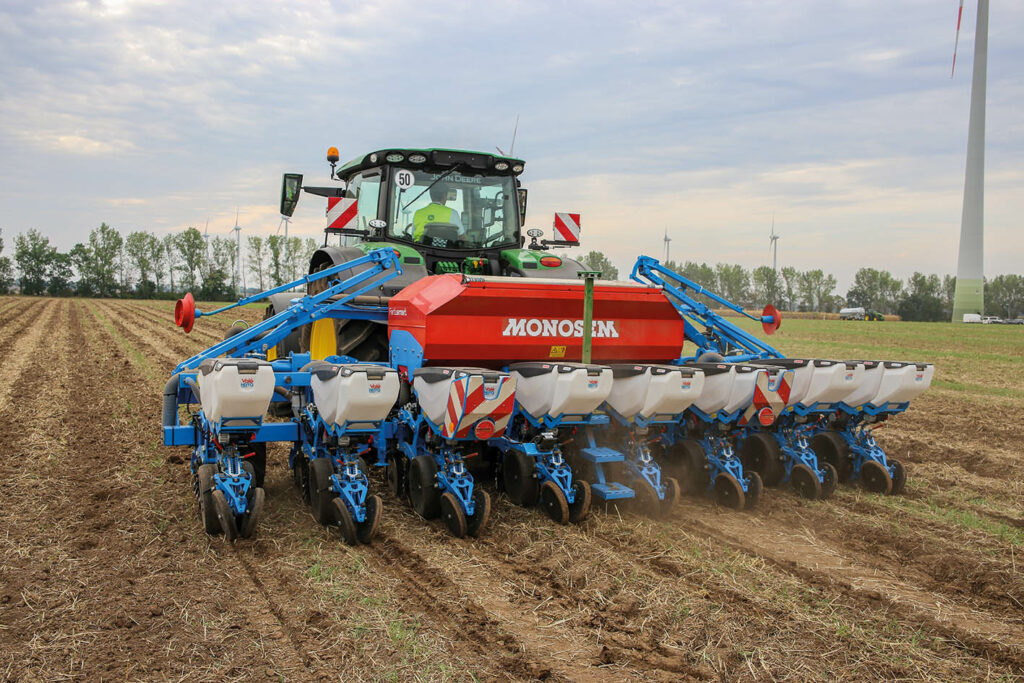
The precision drill uses AutoPath records from the strip-till slurry incorporator.
Accurate fertiliser application
AutoPath was demonstrated at the event (see below) by a contractor who applies slurry through a strip-tillage cultivator, and then establishes maize directly into the tilled ground above the fertilised strips.
Using two Starfire GPS receivers – one on the tractor, and another on the strip-tillage cultivator at the rear of the trailed slurry tanker – the location of the tilled strips and slurry applied below the surface is accurately recorded. AutoPath ensures that the precision planter uses the shared lines of the slurry applicator, avoiding the risk of missing the fertilised strips which could result in up to 30% reduction in yield.
Accurate weeding
AutoPath is also used to ensure the accurate positioning of mechanical weeders (see below). If conventional A-B lines which record the movement of the tractor are used, then any drift of the planter won’t have been documented, so there is a risk that mechanical weeders could damage or remove some of the crop.
With a Starfire receiver mounted on the guided hoe, and AutoPath positioning data shared, precise following of the plant rows is ensured.
